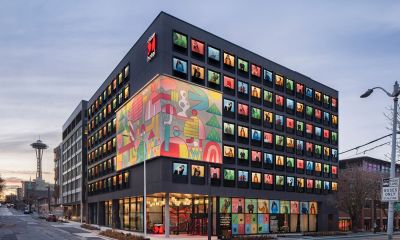L.A. Works, L.A.’s Largest Volunteer Action Center is Organizing L.A.’s Volunteer Power to Address Environmental Justice with Food Festival, Nonprofit Fair, and Eco-Friendly Volunteering Opportunities
LOS ANGELES /PRNewswire/ — L.A. Works invites the Los Angeles community to kick off 2023 in service at the largest volunteer event in LA commemorating Martin Luther King, Jr.’s life and legacy. At the LA Memorial Coliseum in 1964, Dr. King addressed 15,000 Angelenos on the issues of race relations and human dignity. In 2023, L.A. Works continues our long tradition of honoring Dr. King’s legacy on the national holiday by empowering Angelenos to take collective action in the fight for food and climate justice.
The special event is part of the historic venue’s “Coliseum Forever” festivities. It is among the many taking place this year to honor the centennial anniversary of the Coliseum, celebrating some of the most iconic and largest events in Los Angeles that have taken place at the legendary stadium.
“We are excited to invite the community to join together in service at such an iconic venue,” said Deborah Brutchey, executive director of L.A. Works. “Food and climate justice are often overlooked areas when we discuss racial inequity, and with this event we hope to bring attention to their roles in the anti-racism movement.”
Events on Monday, January 16, 2023, at the Los Angeles Memorial Coliseum include:
Food Festival + Nonprofit Fair – Participants will enjoy a sampling of vegan and sustainable foods hosted by local vendors and learn about how to get involved with local nonprofits that are combating the impact of climate change on our communities.
Panel Discussion – In a discussion moderated by filmmaker Jasmine Leyva (The Invisible Vegan), volunteers will hear from expert BIPOC voices in the climate movement.
Volunteer Activities – A series of eco-action stations to create environmentally friendly projects, including creating urban greening kits, engaging in a tree planting pledge, assemble disaster preparedness kits, and building native plant boxes.
When:
Monday, January 16, 2023
12:00pm – 4:00pm
To register, visit laworks.com/MLK.
In addition, L.A. Works will host a special virtual Minecraft March on Washington event on Saturday, January 14, 2023. In this reenactment of the historic March on Washington in the Minecraft game, volunteers tour the National Mall to virtually interact with civil rights leaders who paved the way in the fight against systemic racism.
When:
Saturday, January 14, 2023
10:00am – 12:00pm
VIDEO: Livestream of the 2021 MLK Minecraft experience available here.
To register to volunteer, visit laworks.com/MLK.
PRESENTING SPONSOR: USC Marshall School of Business
SPONSORS INCLUDE: Los Angeles Memorial Coliseum, California Volunteers (Office of the Governor), Jonathan Club, KCET, LISTOS California, Los Angeles Magazine, NBCUniversal, Kaiser Permanente, Target, Cohn Reznick, Discover Los Angeles, Ehrlich Yanai Rhee Chaney Architects, Los Angeles Football Club, Los Angeles Lakers, Lucas Museum of Narrative Art, University of LaVerne, Wescom Foundation, Albertson’s, and the Canadian Consulate.
ABOUT L.A. WORKS
For more than 30 years, L.A. Works has mobilized Angelenos as volunteers to strengthen the fabric of Los Angeles. As the region’s largest and longest running volunteer action center, the nonprofit makes volunteering accessible to bring Angelenos’ time and resources to nonprofits serving a range of needs, from hunger and homelessness to the achievement gap and cultural enrichment. As a unique nonprofit social enterprise, L.A. Works also creates service events and programs for corporations. More at www.laworks.com.
ABOUT THE LOS ANGELES MEMORIAL COLISEUM
The Los Angeles Memorial Coliseum, a living memorial to all who served in the U.S. Armed Forces during World War I, has been a civic treasure for generations of Angelenos. Located in the Exposition Park neighborhood of Los Angeles, CA, the Coliseum is a 77,500 capacity multi-purpose stadium which opened in 1923. Home to the USC Trojans, the legendary stadium has been named as one of the nation’s 40 best stadiums to experience college football by Sporting News, and ranked USC football at the Coliseum as the nation’s No. 3 stadium experience by StadiumJourney.com. Following a recent renovation in 2019, the stadium is now home to a newly added seven-story suite and press tower which includes luxurious suites, loge boxes, club seats, a new press box, and the rooftop 1923 Club with a 360-degree view of the Los Angeles basin; along with several upgrades including new seating, updated technology and concession stands, additional food options for guests, and much more.
The legacy of events and individuals hosted in nine-plus-decades reads like no other, including the only venue to host two Opening and Closing Ceremonies, and the Track and Field Competition for the Summer Olympics (Xth Olympiad in 1932, XXIIIrd Olympiad in 1984) and soon a third (XXXIVth Olympiad in 2028); home to college football’s USC Trojans since 1923 and the UCLA Bruins (1928-1981); professional football’s Los Angeles Rams (1946-1979 and 2016-2019); appearances by U.S. Presidents Franklin D Roosevelt, Dwight Eisenhower, John F. Kennedy, Lyndon Johnson, Richard Nixon, and Ronald Reagan; and international dignitaries such as Martin Luther King, Jr., Cesar Chavez, Pope John Paul II, the Dalai Lama, and Nelson Mandela, to name a few. Additionally, the Coliseum, designated a National Historic monument in 1984, has hosted some of the greatest acts in entertainment, including Bruce Springsteen, The Rolling Stones, Pink Floyd, Prince, and many more. For more information please visit lacoliseum.com.
SOURCE L.A. Works
Related
Discover more from Daily News
Subscribe to get the latest posts sent to your email.





























